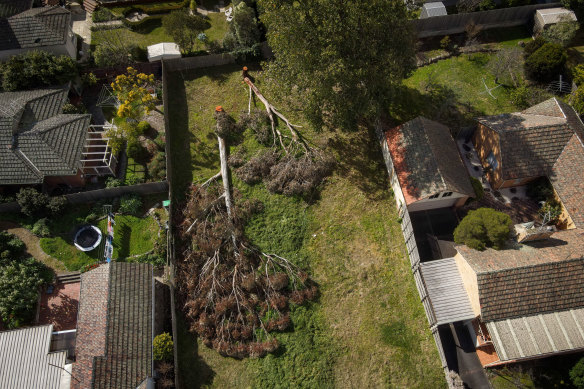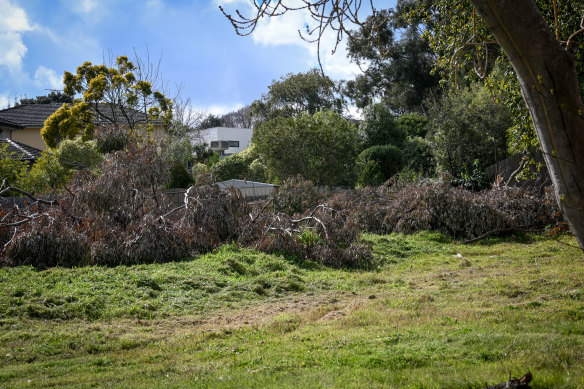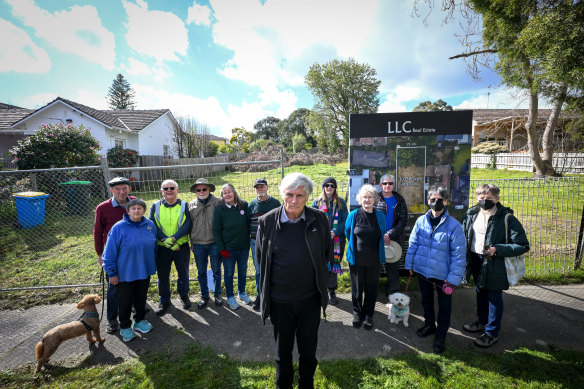By Najma Sambul
Under the cover of darkness, a small truck moves along the quiet streets of Balwyn North. It arrives at a home, the men get out, and the sound of a chainsaw rips through the air. Then, a wood chipper grinds to life. Bit by bit, the evidence is fed through it.
The noisy scene neighbours in the eastern Melbourne suburb are hearing isn’t that of a murder – it’s an illegal tree-removal operation, and business is booming.

Illegal tree removals in Balwyn North. Credit: Eddie Jim
Over the past year, the City of Boroondara has issued more than $100,000 in fines to homeowners and developers for 200 illegal tree removals.
Next door in the City of Stonnington, 22 fines totalling $44,000 have been issued for illegal tree works over the past year. Over five years, 113 fines worth $226,000 were issued.
The illegal activity comes after The Age reported last year on an increase in tree-felling in the City of Whitehorse, where canopy coverage dropped 2.3 per cent in four years.
Ian Hundley, a resident from Balwyn North, which falls under the Boroondara council area, has watched closely over the years as decades-old giant gum trees and oaks in private properties have been cut down, fed into chippers, never to be seen again.
“We see it often, developers who flatten homes built in the 50s and 60s, and remove all the trees in their way to build these ‘McMansions’.”
Greg Paul, Balwyn North resident
He said he has rejected several offers from “fly-by-night” tree removalists who have knocked on his door looking for clients.
“It is pretty widespread in Boroondara,” Hundley said of the illegal operations.
City of Boroondara confirmed it had taken contractors “promoting and engaging in illegal tree works” to court, where they have won some cases. City of Whitehorse, next door to Boroondara, has also instigated court proceedings in the past three years over illegal tree removals.
According to City of Boroondara, homeowners were motivated to cut down trees to extend their properties, install pools, decks, carports, and in some instances trees were poisoned to achieve the plans.

Boroondara council has issued $100,000 in fines for illegal tree removals in the past year.Credit: Eddie Jim
Now Hundley and dozens of other long-term residents in Boroondara are calling for more to be done, including increasing the maximum fine for illegally removing trees, currently $3800. They say the amount, set by the state government, is “a joke”.
Greg Paul, who has lived in Balwyn North since his family moved there in 1949, said fines should increase to $100,000 or planning permits should be removed to deter people from cutting down their trees.
“We see it often, developers who flatten homes built in the 50s and 60s, and remove all the trees in their way to build these McMansions,” Paul said.
“They always advertise the area as the leafy eastern suburbs, but the only ones left are the street trees,” Paul said.
City of Boroondara director of urban living Scott Walker said the council had requested the state government increase the maximum fine to $20,000.
He said the environmental impact and financial value of the trees removed ranged between $30,000 and more than $100,000, depending on the canopy size, far exceeding the maximum penalty for chopping them down.
“Boroondara, along with several other councils, petitioned the state government on several occasions to increase the penalties, but insufficient change has occurred to deter illegal acts of environmental vandalism, tree removal and damage,” Walker said.
“The cost of $3800 for some homeowners and developers in Boroondara is just another operating expense.”
Half of Melbourne’s urban canopy cover is on private land, said Associate Professor Joe Hurley, from RMIT University’s Centre for Urban Research.

Ian Hundley (centre) and other residents outside a property where a tree was illegally removed in Balwyn North.Credit: Eddie Jim
“Boroondara is the heart of the leafy suburbs and the contest for the development uptick. If every individual property owner in Melbourne would be allowed to remove their trees, it would destroy the essential green infrastructure in our city,” Hurley said. “We can have increased housing and maintain canopy cover, it just takes good planning and design.”
University of Melbourne arboriculture expert Greg Moore said Melbourne’s eastern suburbs have lost about 10 per cent of their canopy cover over the past decade.
“Many developers consider the fines just a cost of doing business. The state government planning laws are the real problem; they offer little protection for trees and fail to place any real value on them,” he said.
“The tree removals will have a huge impact on health costs as climate warms and during heatwaves in particular. Loss of canopy cover will add millions of dollars to health costs – it really is a matter of life and death,” Moore said.
The Urban Development Institute of Australia’s president, Maxwell Shifman, said the vast majority of developers were following the rules when it came to tree removals.
“Some councils have adopted onerous rules for tree retention on private property, which can be a major impediment to the competing goals of urban greening and renewing housing stock, but that does not justify breaking the law,” said Shifman, who is also the chief executive of developer group Intrapac.
“Development needs to strike a balance between protection of significant vegetation, and the need to allow some removal or replacement for practical reasons.”
A Victorian government spokesman said councils had the responsibility for protection of sensitive landscapes and a “suite” of controls to use to protect trees.
The Morning Edition newsletter is our guide to the day’s most important and interesting stories, analysis and insights. Sign up here.